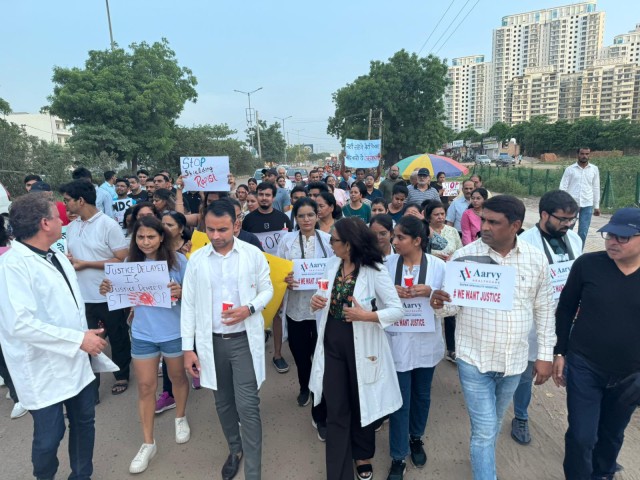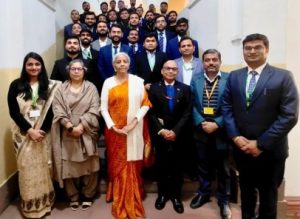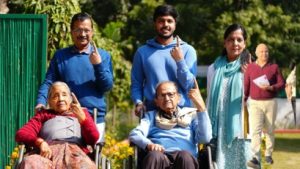Alarming rise in crimes against women in Metro cities

Image credit X.com @leenadhankhar
Safety and freedom to live as fearless citizens is a collective effort
By Pradeep Kumar Panda
Bhubaneswar, August 28: According to the Crime in India 2022: Statistics Volume 1, the annual report by the National Crime Records Bureau, there was a 4% rise in the registered crimes against women in 2022, compared to the previous year.
In absolute numbers, the total number of registered crimes against women was 4,45,256 cases in 2022. Of these, 31.4% were registered under “cruelty by husband or his relatives,” 19.2% were “kidnapping and abduction of women,” 18.7% were of “assault on women with intent to outrage her modesty,” and 7% were cases under “rape.”
Also Read: Imagining safe workplace for lifesavers
Similarly, there was a significant rise of 8.7% in crimes against children in 2022, which amounts to 1,62,449 registered cases. Among these, 45.7% of cases constituted of “kidnapping and abduction” and 39.7% of cases were under the Protection of Children from Sexual Offences Act, 2012.
The rise in crime rates registered is higher in the metropolitan cities. It is important to note, as the report also cautions, that these are just the cases registered with the police. There could be a vast gap between the actual crimes committed and those reported.
A time-bound justice and sensitive judiciary are fundamental to fight back this grim reality and restore the sense of trust in society. Despite the efforts from civil society and the legal community for judicial reforms, the ground reality is dismal and it hardly comes under media scrutiny.
Also Read: Champai Soren cites Bangladeshi infiltration to unyoke with JMM
The study by the Supreme Court, titled the State of the Judiciary: A Report on Infrastructure, Budgeting, Human Resources and ICT (2023), states that there are over five crore pending cases in India dealt with by 20,580 judges across the Supreme Court, high courts, and district courts.
The report found that more than 42.9% of courtrooms have been under construction for over three years. There are a staggering number of issues plaguing the judiciary when it comes to having a basic infrastructure in place.
Some of these are serious shortages of judicial support staff, vacancies of judges, non-compliance with the recruitment timelines and extreme delays, lack of courtrooms, washrooms, poor representation, limited digitisation, e-filing facilities and videoconferencing facilities and so on.
Also Read: Pharma intermediary sparkles with sharp stock price gains
A strong and sound judiciary is not simply “strong punishment” or a “strong law” but the whole mechanism of the justice delivery system. Additionally, there are challenges of pronouncing judgments fearlessly without the threats of mobs, media trials, or political pressures.
In the last decade or so, all discussions on social justice, socio-economic issues, and human rights have disappeared from the mainstream media. Today, any attempt at critique is seen as “anti-religion,” “anti-national” or “anti-establishment.”
The government’s focus on women’s empowerment through schemes, cash transfers, or nutritional programmes, though important, becomes the dominant national and regional narrative of change.
And hence, when incidents like the release of convicted gang rapists in the Bilkis Bano case, abuse of a large number of women in Manipur in the ongoing conflict, and the battle by women wrestlers against the ex-chief of the Wrestling Federation of India happens, the media-created bubble of good governance and toxic positivity bursts.
Also Read: Cabinet Secretary seeks intense focus on ‘Purvodaya’
The public outrage derails this image-management wagon dragged on for too long by the divisive media.
On 9 August 2024, the nation was shocked, yet again, when the news of a woman doctor’s brutal rape and murder in a hospital in Kolkata hit the headlines.
As the details of the gruesome nature of the crime and the working conditions of doctors were reported in the media, the citizens and resident doctors across the country erupted in protest. They were right in doing so.
Their colleague, a fellow citizen, was assaulted and killed in the most dehumanising manner. A civic police volunteer was arrested immediately as a suspect.
For many years now, doctors have been demanding greater safety measures in hospitals as they are often subjected to violent attacks, while on duty. But what happened on 9 August 2024 was a moment of a complete breakdown of their patience.
Also Read: BJP’s ‘steel frame’ loses lustre ahead of key polls
There are now more resident doctors speaking up against the abusive work environments where ragging, bullying, and harassment by colleagues, seniors, professors and patient’s relatives, are rampant.
The issue today, however, is not limited to the poor working conditions alone but the persistence of structural abuse faced by women and children all over the country.
Two equally brutal cases of sexual abuse, and in one case murder of Dalit children, were reported in the week following the Kolkata case.
In Muzaffarpur, Bihar, a 14-year-old Dalit girl child was abducted, allegedly raped and murdered by the middle-aged prime accused who had threatened the victim’s family for turning down his marriage proposal.
In Bulandshahr, Uttar Pradesh, an assistant development officer of the agriculture department raped a 10-year-old Dalit child in her own house. As we read in utter shock and write about more such cases, parents in Badlapur, Maharashtra, have hit the streets in protest against the sexual abuse of two children on their own school premises.
Also Read: Rail stock nearly doubles in one month on safety push
A hospital, a home, a neighbourhood, a school, or a workplace, all these are supposed to be sites of care, safety, shelter and growth, surrounded by the “known” people.
The knee-jerk reaction of the institutions and governments is to restrict the movement of women at certain times and spaces. The subject of sensitisation across genders against patriarchal cultures and practices gets a footnote mention.
There are, of course, efforts at the individual level towards gender sensitisation but they need to be supported by large-scale and consistent government, institutional and community interventions so that gender-sensitive education and culture become mainstream and are not restricted to a one-time workshop or a campaign.
We have conveniently avoided the most important discussion about why these cases keep occurring and what measures have been taken to prevent them. How does the culture of impunity, selective outrage, and complete silence when the accused is a powerful person enable misogynist violence and exploitation?
Also Read: Nepal FM’s India visit marks shifting sands in bilateral relations
We will yet again focus all the attention on a few rotten apples when the problem lies in the whole poisoned orchard that needs uprooting.
The outbreak of the frustrated public emotion, as seen in Kolkata and Badlapur, is also a desperate need to break away from this media-created echo chamber that people knew did not represent their reality, their experiences, and their worst fears.
Safety and freedom to live as fearless citizens is a collective effort; no one can be excluded from it. This can only be shaped by a larger philosophical commitment against patriarchy and all kinds of violence rooted in the idea of superior–inferior or dominant–subordinate.
It requires a humanitarian vision and action and not a majoritarian impulse that bullies the vulnerable and marginalised people into further silence.
Also Read: Modi govt succumbs to pension politics with nod to UPS
When politics is reduced to gathering crowds of followers on non-issues, display of eloquent rhetoric, whipping up emotions through provocative speeches or indulging in huge expenditures, it translates into precarious living conditions for the citizens.
The real progressive politics of development involves the hard work of transforming the unequal and oppressive social order. This work is slow, gets no instant validation, and involves no high-decibel arguments but listening and questioning through conversations; it has no theatrics and spectacle but gradual conscientization. It is a daily routine work informed by a dramatic vision and radical commitment for a just, democratic society.
(Views expressed in the article solely belong to the author)
Join WhatsApp channel of The Raisina Hills







